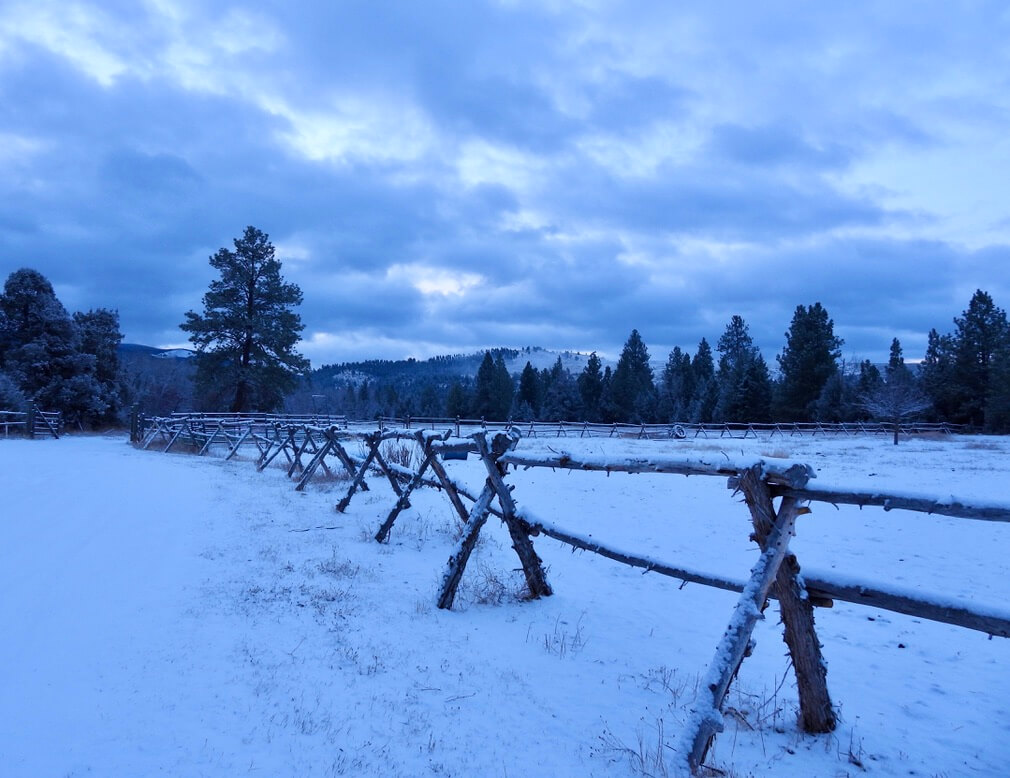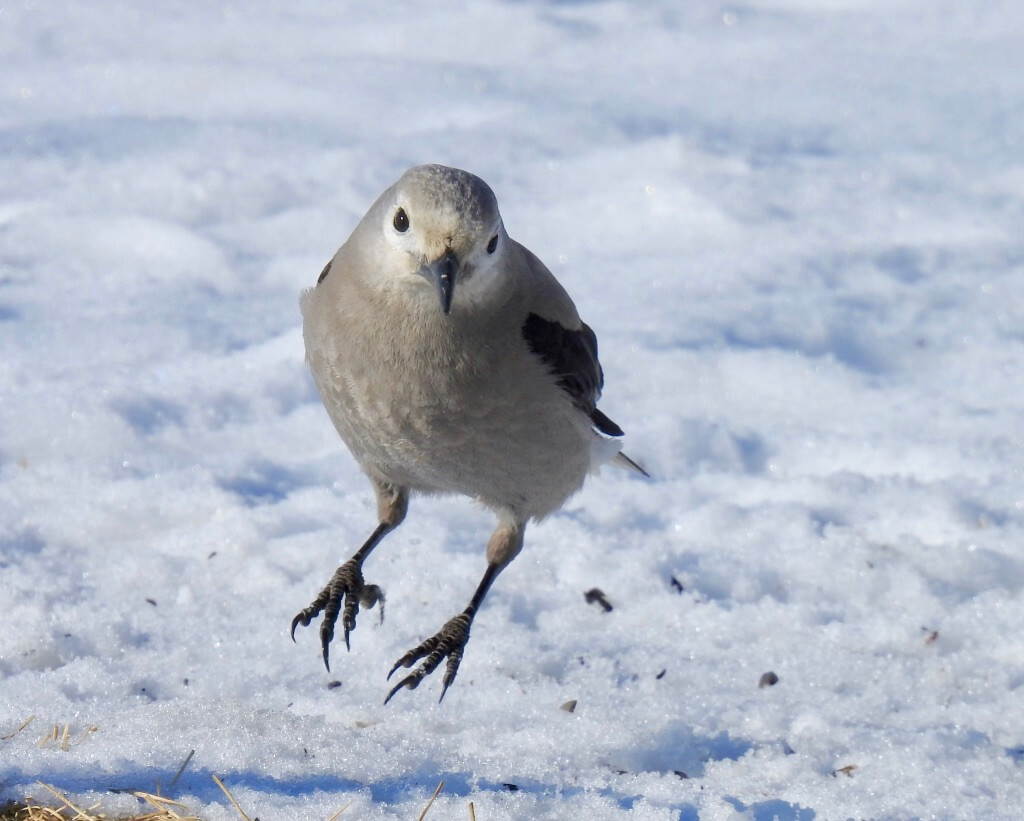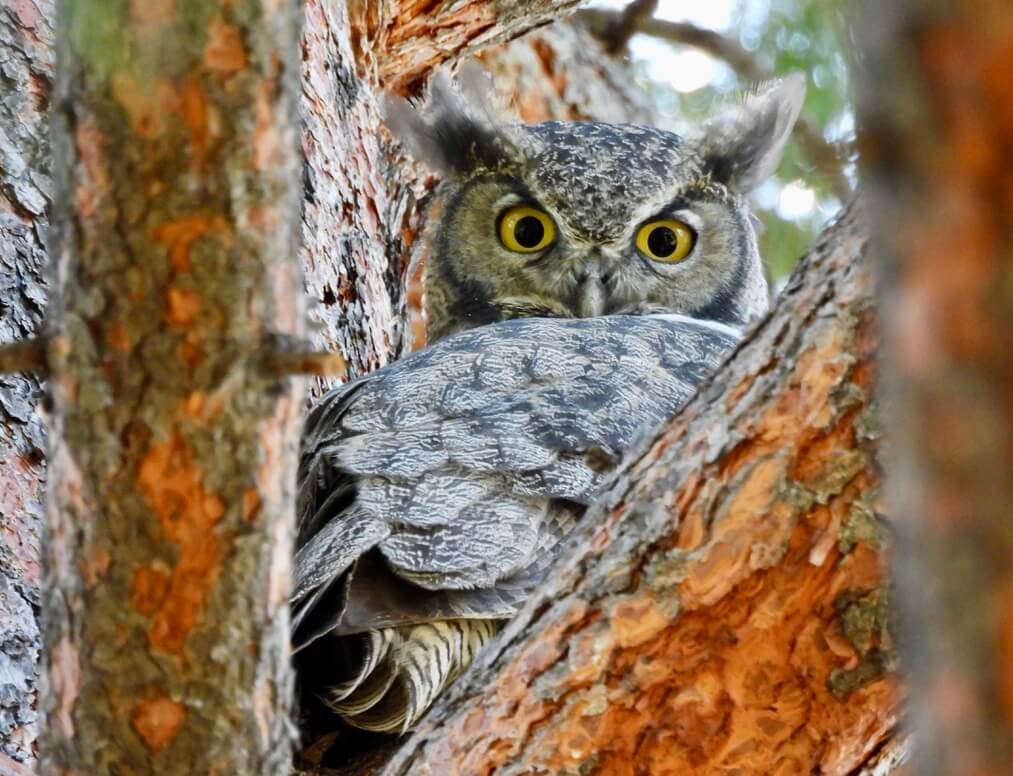Homage to the Sapphire Foothill Habitat and to Mother Nature
by Micki Long
Broadcast 12.15 & 12.18.2021

View of the wintry Sapphire foothills. Photo © Micki Long.
Listen:
The moon lit up my yard that morning, when I went out with the dogs at 6:30. Recently fallen snow in the surrounding Sapphire foothills reflected the full moon’s light. I could see almost as well as during the day. The horses in the pasture watched us, as I’m sure they do each morning, though we usually can’t see them. The trees and shrubs glowed in the bluish predawn. To the south, in the woods, the Great Horned Owls sang to each other: the low, slow call of the male, the higher, faster response of the female, the duet beautifully haunting in the strange yet natural light that slowly became more blue.

Clark’s Nutcracker. Photo © Micki Long.
Back inside, drinking coffee and looking out the picture window to the west, I watched the mountains across the valley, St. Mary’s Peak most prominent, become more distinct from the low clouds hanging on their ridges. One of the dogs, Tess, sat on a chair across from me and watched for movement in the yard. She too loves to watch Clark’s Nutcrackers sail down from the trees, and chickadees and nuthatches fly back and forth from shrubs to feeders. The undulating flight of birds in the distance, approaching the yard, marks them as woodpeckers, first a Downy and then a Hairy. The raucous calls of magpies, Steller’s Jays, and Clark’s Nutcrackers don’t disturb the peace and joy I feel but add color and flavor to it.
That morning, I couldn’t help but argue with Tennyson, specifically with one of his most famous lines of poetry. Yes, “nature is red in tooth and claw.” Tess often finds—and eats—bits of deer, mostly legs but once what seemed to be a trachea, evidence of lion kills in the woods across the pasture, evidence that nature is indeed bloody. Nature is also competition for survival: Clark’s Nutcrackers fight among themselves and with flickers, magpies, Hairy Woodpeckers, and Steller’s Jays for the suet I leave them. She is anger, as anyone who has been chided by a red squirrel or chickadee for crossing some unseen perimeter is well aware.

A Great Horned Owl peers down from a ponderosa branch. Photo © Micki Long.
But Nature is so much more than violence and aggression. She is joyful: raptors riding the thermals, circling and circling; young fawns romping in the yard like puppies. She is curious: a young Red-tailed Hawk flying low, right above us as we walk in the woods. Nature is brave: the Evening Grosbeak who landed on the rim of my pitcher as I neared the feeders, looked me in the eye, and jumped, feet-first, into the pitcher to gorge on black oil sunflower seeds. And she is nurturing: it won’t be long before those Great Horned Owls have eggs to protect. They will take great care to protect their young, as will the coyotes, deer, and other wildlife passing through the yard and the foxes, magpies, and lions living in the woods.
And, Lord Tennyson, Nature is serenity; she is peace: a pair of fawns resting under the tree, near the sleeping wild turkeys; a huge mama bear, lounging in the middle of the yard, her cubs nearby. (Yes, I scare them away, hoping they find a quiet and safe spot farther from human homes). And I too am a creature of Nature, like all human beings but especially those who love exploring the woods and mountains, who love sitting on the banks of a creek and listening to the water playing over and around rocks, and who also stand outside, maybe with their dogs and horses, as the full moon bathes them in magic and owls serenade each other.
Every week since 1991, Field Notes has inquired about Montana’s natural history. Field Notes are written by naturalists, students, and listeners about the puzzle-tree bark, eagle talons, woolly aphids, and giant puffballs of Western, Central and Southwestern Montana and aired weekly on Montana Public Radio.
Click here to read and listen to more Field Notes. Field Notes is available as a podcast! Subscribe on Apple Podcasts or wherever you listen to podcasts.
Interested in writing a Field Note? Contact Allison De Jong, Field Notes editor, at adejong [at] montananaturalist [dot] org or 406.327.0405.
Want to learn more about our programs as well as fun natural history facts and seasonal phenology? Sign up for our e-newsletter! You can also become a member and get discounts on our programs as well as free reciprocal admission to 300+ science centers in North America!












